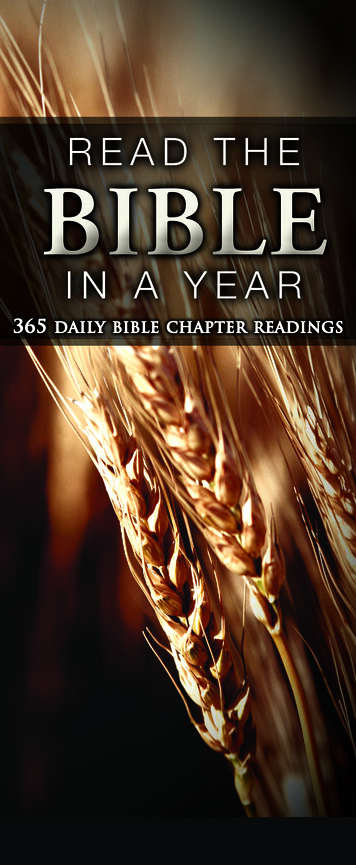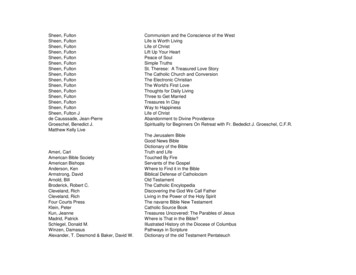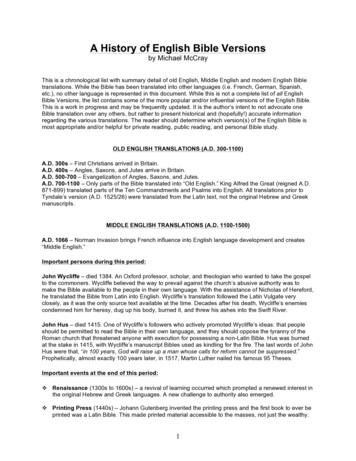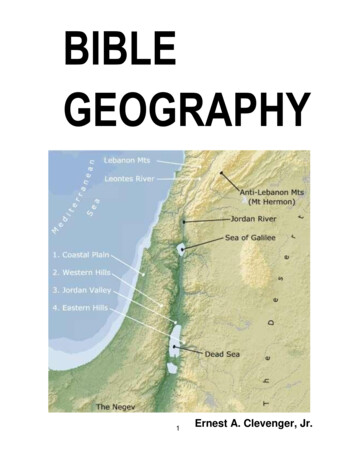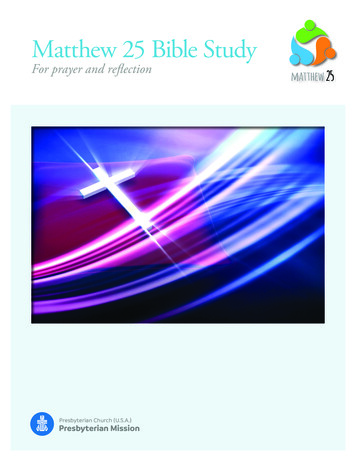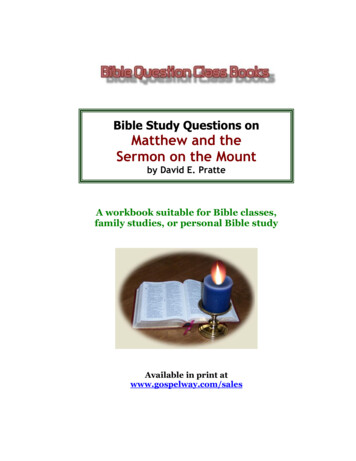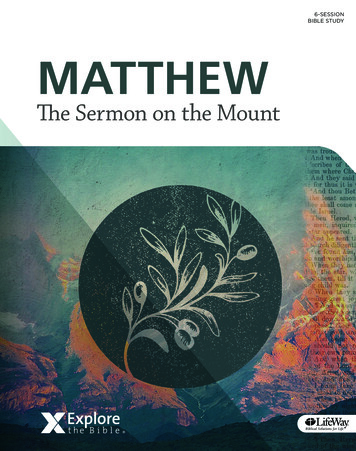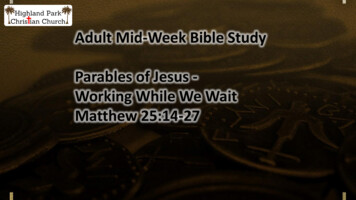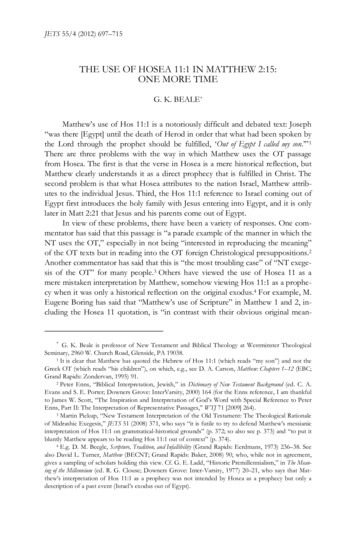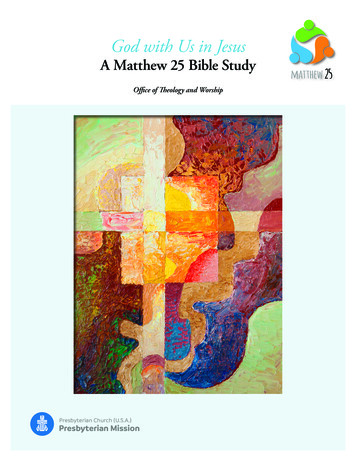
Transcription
God with Us in JesusA Matthew 25 Bible StudyOffice of Theology and WorshipPresbyterian Church (U.S.A.)Presbyterian Mission
God with Us in JesusA Matthew 25 Bible StudyOffice of Theology and WorshipOpening PrayerSovereign God,let your Word rule in our heartsand your Spirit govern our livesuntil at last we see the fulfillmentof your realm of justice and peace;through Jesus Christ our Lord. Amen.Book of Common Worship (WJKP, 2018), 396Presbyterian Church (U.S.A.) Matthew 25 3
Introducing the Gospel of MatthewMatthew is the first book in the New Testament and the first of the four Gospels — ancient accounts of the life,death and resurrection of Jesus Christ. Although Matthew is first in biblical order, it is thought to have been writtensometime after the Gospel of Mark. Indeed, the authors of Matthew and Luke seem to borrow from and build onMark’s work, resulting in a great deal of overlapping material among these three Gospels. John, the fourth Gospel,stands apart with a different structure and contents, even as it bears witness to similar events.Biblical scholars believe the Gospel of Matthew was written sometime after the year 70 in the Common Era (CE),probably in Antioch (modern Turkey) or southern Galilee (modern Israel/Palestine). Matthew was written with aJewish audience in mind, presenting Jesus as the new Moses who had come to redeem the people. The distinctiveorganization of Matthew into five sections, as described below, mirrors the five books of Moses, or Torah (Genesis,Exodus, Leviticus, Numbers and Deuteronomy). Composed at a time when many Gentiles (non-Jews) were beingdrawn to the Christian faith, the Gospel seeks to emphasize the Jewishness of Jesus.The Gospel of Matthew begins with a prologue describing the genealogy and infancy of Jesus (Matthew 1:1–2:23).It ends with the accounts of his betrayal, trial, suffering and death (Matthew 26:1–27:66) and resurrection (Matthew28:1–20). Between these bookends are the five “books” of Matthew, each consisting of stories of Jesus’ ministryfollowed by accounts of his teaching to the disciples: (1) proclaiming the realm of God (Matthew 3:1–7:29), (2)ministry in Galilee (Matthew 8:1–11:1), (3) controversy and parables (Matthew 11:2–13:53), (4) formation of thedisciples (Matthew 13:54–19:2), and (5) the journey to Jerusalem (Matthew 19:3–25:46). Notice that the fifth “book”ends with Matthew 25:31–46.There is an important theological idea “bookending” the Gospel of Matthew as well — the theme of “God withus” in Jesus Christ. When the coming of Jesus the Messiah is announced by an angel in the first chapter of theGospel, Matthew quotes the prophet Isaiah: “‘Look, the virgin shall conceive and bear a son, and they shall name himEmmanuel,’ which means, ‘God is with us’” (Matthew 1:23; see also Isaiah 7:14). In the last chapter of the Gospel,the risen Lord speaks these final words to his disciples: “And remember, I am with you always, to the end of the age”(Matthew 28:20).Questions for Reflection or Discussion Why is it important to consider the structure and intended audience of the Book of Matthew? What do theyreveal about the purpose of the Gospel? How would the theological theme of “God with us” in Jesus Christ speak to early Christians? How does itspeak to us today? What might “God with us” mean for the work of eradicating systemic poverty, dismantling structural racismand building congregational vitality?Matthew 25:31–46 in ContextRead Matthew 25:31–46. You may use or adapt the choral reading found in the appendix of this document. (If timepermits, you may wish to read Ezekiel 34:1–31 first.)The vision of God’s judgment in Matthew 25:31–46 is the last passage in the fifth and final “book” of the Gospel ofMatthew. It stands at the threshold, pointing to the conclusion to the Gospel with the death and resurrection of JesusChrist. Indeed, the next words of Matthew are: “When Jesus had finished saying all these things, he said to his disciples,‘You know that after two days the Passover is coming, and the Son of Man will be handed over to be crucified’”(Matthew 26:1–2; italics added). The intentional placement of this story, unique to Matthew’s Gospel, makes itparticularly worthy of careful consideration.When early Christians heard Matthew 25:31–46, they might have noticed strong references to the prophet Ezekiel.Ezekiel had harsh words of condemnation for political and religious leaders who failed to seek the welfare of thoseentrusted to their care, instead profiting from their oppression. So, the prophet cried out: “Ah, you shepherds of Israelwho have been feeding yourselves! Should not shepherds feed the sheep?” (Ezekiel 34:2). In ancient Israel, “shepherd”was a common metaphor for “king.”Through the voice of Ezekiel, the Lord declares judgment against the false shepherds who have scattered,endangered and exploited the sheep: “You eat the fat, you clothe yourselves with the wool, you slaughter the fatlings;4 Introducing the Gospel of Matthew
but you do not feed the sheep. You have not strengthened the weak, you have not healed the sick, you have not boundup the injured, you have not brought back the strayed, you have not sought the lost, but with force and harshnessyou have ruled them” (Ezekiel 34:3–4). This litany of accusation provides the pattern for Jesus’ solemn reproaches tothe “goats”: “I was hungry and you gave me no food, I was thirsty and you gave me nothing to drink, I was a strangerand you did not welcome me, naked and you did not give me clothing, sick and in prison and you did not visit me”(Matthew 25:42–43).As for the people those leader (or false shepherds) were supposed to be taking care of, God proclaims: “I myselfwill search for the sheep” (Ezekiel 34:11); “I will feed them with good pasture” (Ezekiel 34:14). “I myself will be theshepherd of my sheep, and I will make them lie down, says the Lord God. I will seek the lost, and I will bring backthe strayed, and I will bind up the injured, and I will strengthen the weak” (Ezekiel 34:15–16). This promise seemsto prefigure Jesus’ revelation to the “sheep”: “I was hungry and you gave me food, I was thirsty and you gave mesomething to drink, I was a stranger and you welcomed me, I was naked and you gave me clothing, I was sick and youtook care of me, I was in prison and you visited me” (Matthew 25:35–36). Ezekiel goes on in this chapter to describeGod’s judgment between the sheep and the goats, another strong and clear parallel with Matthew 25.With the words of Ezekiel in mind, we may have a clearer sense of what Jesus is saying to the church and forthe world. There are striking similarities between these passages, but Jesus reinterprets Ezekiel’s prophecy in threeimportant ways: First, Jesus reveals his own presence in an unexpected way: among people who are hungry, thirsty, strangers, naked, sick and in prison. The one who is coming to judge and reign identifies not with the proud andpowerful, but with people in desolation and danger. This is consistent with Matthew’s theological emphasison Jesus as “Emmanuel” — God with us here, now and always. Second, in Matthew 25 the subject of God’s judgment is not the rulers of Israel but the people of “thenations” (another way of saying Gentiles). New believers are called to join the people of God, but only thosewho have cared for “the least of these” (Matthew 25:40, 45) will inherit the kingdom of heaven. This is consistent with the context and concerns of the Gospel writer — sorting out the relationships between Jews andGentiles in the emerging church. Third, this vision of divine judgment puts us in the place of decision. It compels us to examine our ownlives: Will we be counted among the sheep or the goats? It invites us to respond: How will we see and servethe Lord today? This is consistent with the Gospel’s purpose in bearing witness to the life, death and resurrection of Jesus Christ.Questions for Reflection or Discussion How do the parallels with Ezekiel 34 influence your understanding of Matthew 25? What new insights doyou find in the relationship between these passages? What is Jesus saying to the church through his reinterpretation of Ezekiel’s prophecy? What is he saying forthe sake of the world beyond the church? In light of Ezekiel 34, what does Matthew 25 reveal about the life, death and resurrection of Jesus Christ?How are we called to respond to this good news?Three Implications for the Church in Our TimeThis critical and compelling passage in Matthew’s Gospelhas become an important focus in the mission and ministryof the Presbyterian Church (U.S.A.). Specifically, it informs,inspires and influences our work on three strategic priorities:eradicating systemic poverty, dismantling structural racismand building congregational vitality. The brief sections thatfollow will demonstrate how Matthew 25:31–46 speaksto — and leads us to pursue — these areas of work. Theyalso give us an opportunity to consider three different waysof interpreting the biblical text: a literal/plain reading, ahistorical/critical reading and a spiritual/symbolic reading.Presbyterian Church (U.S.A.) Matthew 25 5
Eradicating Systemic PovertyHow does Matthew 25:31–46 inform the church’s work in eradicating systemic poverty? In this case, a literal/plain reading of the text speaks volumes. We are called to serve Jesus by contributing to the well-being of the mostvulnerable in society: sharing our possessions with people who are deprived of adequate food and clean drinking water;offering hospitality to people who need warm clothing and safe shelter; and providing assistance for people who lackaccess to medical care or languish in prison. As the prophet Micah might say, when we do justice, show kindness andwalk humbly alongside people in such situations, we do what is right and good in the sight of the Lord (Micah 6:8).This means recognizing the image of God and the presence of Christ in the faces of our neighbors — particularlyneighbors in need — and then honoring God’s image and Christ’s presence by loving our neighbors as ourselves.But there is more. Remember that Jesus’ words were inspired by a prophet’s challenge to leaders who neglected andabused their people, telling them their reign of corruption and cruelty had come to an end. In the background of thisstory from Matthew is a prophetic challenge: to engage our leaders, speaking truth to power and demanding changeto the systems that perpetuate poverty and allow some to profit from oppression of others. Make no mistake, Jesus iscalling us to perform ordinary acts of compassion in daily life: sharing food, drink and clothing with those who arehungry, thirsty and naked; offering welcome, care and company to those who are outcast, suffering and captive. Butwe are also called us to consider the factors that led to these conditions, to confront the causes of inequality, to confessthe sin of greed and to correct the problem of poverty — whether in our own nation and neighborhood, or aroundthe world. In so doing, we continue Christ’s work of proclaiming release to captives and good news to the poor (Luke4:18–19) — the good news of God’s righteousness, justice and peace for all.Questions for Reflection or Discussion What insights does Matthew 25:31–46 have to offer about poverty? What does it mean to address poverty in both individual and systemic ways? Can you think of examples of each? Where, when and how have you seen — or can you imagine — Jesus revealed in the church’s work oferadicating systemic poverty?Dismantling Structural RacismHow does Matthew 25:31–46 inspire the church’s workin dismantling structural racism? In this matter, a historical/critical reading of the text is instructive. When we look closelyat the original language of the Gospel (Koine Greek), certainwords leap from the page. Jesus describes the day when “all thenations” (panta ta ethne) will gather before the Son of Man,enthroned in glory (Matthew 25:31). As discussed above,the word “nations” (ethne) was a way to refer to Gentiles, ornon-Jews; this is also the Greek word from which we derivethe terms “ethnicity” and “ethnocentrism.” This vision of thecoming of God’s realm is echoed in Revelation, where thereis “a great multitude that no one could count, from everynation, from all tribes and peoples and languages, standingbefore the throne” (Revelation 7:9). A few verses later, whenJesus says, “I was a stranger and you welcomed me” (Matthew25:35), the word for “stranger” is xenos (from which we derive“xenophobia”), meaning “foreign” or “alien,” and the word for“welcome” is sunegagete (from which we derive “synagogue”),meaning “gather” or “bring together.” When we welcomeothers, we welcome Christ; when we bring together people whoare divided, we are doing God’s reconciling work.But there is more. Remember that Matthew was writtenin the context of cultural conflict in the early church —controversies over what it meant to be Jewish and Christian,6 Introducing the Gospel of Matthew
concerns about the influence of Gentile believers, and the growing pains of a newly multi-ethnic body of Christ.Early Christian leaders compared the church to a temple, built on the cornerstone of Christ, with members as “livingstones” (see Ephesians 2; 1 Peter 2). But the first Christians were already beginning to see signs of strain, cracks in thearchitecture. The writer of Matthew was intent on breaking down dividing walls and building up the church on a firmfoundation — the identity and mission of Jesus Christ as Lord and Savior of all people. Accordingly, Matthew beginswith Jesus’ Epiphany to travelers from a distant land (Matthew 2:1–12) and ends with his Great Commission: “Gotherefore and make disciples of all nations ” (Matthew 28:19). Jesus’ words in Matthew thus challenge us to addressstructural problems of racism, prejudice and privilege — all for the sake of the whole world God loves.Questions for Reflection or Discussion What insights does Matthew 25:31–46 have to offer about racism? What does it mean to confront racism in both personal and structural ways? Can you think ofexamples of each? Where, when and how have you seen — or can you imagine — Jesus revealed in the church’swork of dismantling structural racism?Building Congregational VitalityHow does Matthew 25:31–46 influence the church’s work in building congregational vitality? In this instance,a spiritual/symbolic reading of the text uncovers new layers of meaning. The Gospels were written for churches: earlyChristians who gathered on the Lord’s Day to proclaim the Word and celebrate the Sacraments. When Matthew’saudience heard of sharing food and drink, surely it would have whetted their appetite for the bread and cup of Lord’sSupper, in which Jesus offers us his very life (or vitality). When they heard of clothing the naked and welcomingstrangers, surely it would have caused them to remember our common Baptism, in which we are cleansed, claimed andcovered in Christ’s grace. When they heard of visiting those who are sick and in prison, surely it would have evokedthe preaching of the gospel, in which we are healed from sin and set free from death. These central acts of Christianworship are a key to the vitality of the church. Indeed, church leaders in the Reformation, such as John Calvin,identified Word and Sacrament as “marks” or “notes” of the true church (Institutes, 4.1.9) — sure signs of the life andwork of Christ among us.But there is more. Remember that the purpose of a Gospel is to bear witness to the life, death and resurrection ofJesus Christ. Just as the crucified and risen Lord made himself known to disciples on the road to Emmaus through theinterpretation of Scripture and the breaking of the bread (Luke 24:13–35), in Matthew 25, Jesus is with us here andnow as bread for people who are hungry and good news to people who are poor. We might think of this as the “gospelof solidarity” or the “sacrament of the neighbor.” Jesus Christ is “truly present and active among us, by the power ofthe Holy Spirit” (W-1.0106) through the church’s worship and service. As we are fed at the table, we go forth to feedothers. As we are welcomed at the font, we go forth to welcome our neighbors. As we are set free by the gospel, we goforth to proclaim Christ’s liberating power to all. Through these marks of the church and “vital signs” of the gospel, weproclaim to the world that “The Lord is risen indeed!”Questions for Reflection or Discussion What insights does Matthew 25:31–46 have to offer about vitality in Christ? What does it mean to support vitality in both local (congregational) and connectional (denominational,ecumenical) ways? Can you think of examples of each? Where, when and how have you seen — or can you imagine — Jesus revealed in the church’s work ofbuilding congregational vitality?Connecting the DotsThe more we learn about systemic poverty, structural racism and congregational vitality, the better weunderstand the connections and intersections between these three aspects of the work of the church. For instance,the disproportional impact of economic inequality on people of color reveals the intersection between eradicatingsystemic poverty and dismantling structural racism. The vibrancy and strength of multicultural communities of faithdemonstrates the connection between dismantling structural racism and building congregational vitality. The purposeand growth of churches actively engaged in mission sheds light on the link between building congregational vitalityand eradicating systemic poverty. At the heart of these convergences is none other than Jesus Christ — the one inPresbyterian Church (U.S.A.) Matthew 25 7
whom “all things hold together” and “the head of the body, the church” (Colossians 1:17–18).Are there other priorities the church can and should pursue? Certainly. Are eradicating systemic poverty,dismantling structural racism and building congregational vitality the only aspects of the church’s mission and ministryto which Jesus speaks in Matthew 25? Certainly not. But we have discerned that — for this church, in this time andin this place — we can best serve Christ by focusing our work in these three areas. We commit ourselves to this workknowing that this is where Christ is and what Christ is doing already, and thus where the church should be as well.Questions for Reflection or DiscussionIn your personal life, in the ministry of your congregation, and through the church’s mission in the world how can you contribute to the work of eradicating systemic poverty? how can you contribute to the work of dismantling structural racism? how can you contribute to the work of building congregational vitality?The Gospel of Matthew begins by proclaiming the good news that God is with us in Jesus, Emmanuel (Matthew1:23). Matthew 25 teaches us how we can be with Jesus — by serving our neighbors in need, breaking down dividingwalls and building up the body of Christ. To those who follow God’s way and join in this mission, Jesus promises: “Iam with you always, to the end of the age” (Matthew 28:20).Closing PrayerCome quickly, Emmanuel, in power and glory,to establish your realm of justice and peace;and make us ready, on the day of redemption,to stand before you, our Savior and Lord. Amen.Book of Common Worship (WJKP, 2018), 170The need for discernment in hearing God’s call in these verses is explored in “Bringing Matthew 25 Into Focus,” a paper that accompanies thisstudy. It can be found at -25-resources.8 Introducing the Gospel of Matthew
A Choral Reading of Matthew 25:31–46 (New Revised Standard Version)The reading is arranged for four voices (A, B, C and D); alternately, the bold type may be spoken in unison by a group,perhaps divided into right- and left-hand sides. Note that Jesus is speaking about himself in the third person in thispassage: Jesus is the Narrator and the figure of the King/Shepherd (or Son of Man), although this script assigns twodifferent voices to those roles.A Narrator (Jesus):31“When the Son of Man comes in his glory, and all the angels with him, then hewill sit on the throne of his glory. 32 All the nations will be gathered before him, andhe will separate people one from another as a shepherd separates the sheep from thegoats, 33 and he will put the sheep at his right hand and the goats at the left. 34 Thenthe king will say to those at his right hand,B King/Shepherd:‘Come, you that are blessed by my Father, inherit the kingdom prepared for you fromthe foundation of the world; 35 for I was hungry and you gave me food, I was thirstyand you gave me something to drink, I was a stranger and you welcomed me, 36 I wasnaked and you gave me clothing, I was sick and you took care of me, I was in prisonand you visited me.’A Narrator (Jesus):37C Sheep/Right Hand:‘Lord, when was it that we saw you hungry and gave you food, or thirsty andgave you something to drink? 38 And when was it that we saw you a stranger andwelcomed you, or naked and gave you clothing? 39 And when was it that we sawyou sick or in prison and visited you?’A Narrator (Jesus):40B King/Shepherd:‘Truly I tell you, just as you did it to one of the least of these who are members of myfamily, you did it to me.’A Narrator (Jesus):41B King/Shepherd:‘You that are accursed, depart from me into the eternal fire prepared for the devil andhis angels; 42 for I was hungry and you gave me no food, I was thirsty and you gaveme nothing to drink, 43 I was a stranger and you did not welcome me, naked and youdid not give me clothing, sick and in prison and you did not visit me.’A Narrator (Jesus):44D Goats/Left Hand:‘Lord, when was it that we saw you hungry or thirsty or a stranger or naked orsick or in prison, and did not take care of you?’A Narrator (Jesus):45B King/Shepherd:‘Truly I tell you, just as you did not do it to one of the least of these, you did not doit to me.’A Narrator (Jesus):46Then the righteous will answer him,And the king will answer them,Then he will say to those at his left hand,Then they also will answer,Then he will answer them,And these will go away into eternal punishment, but the righteous into eternal life.”Presbyterian Church (U.S.A.) Matthew 25 9
Presbyterian Church (U.S.A.)Presbyterian Mission100 Witherspoon St. Louisville, KY 40202PDS: PDS #10-050-21-007
Read Matthew 25:31-46. You may use or adapt the choral reading found in the appendix of this document. (If time permits, you may wish to read Ezekiel 34:1-31 first.) The vision of God's judgment in Matthew 25:31-46 is the last passage in the fifth and final "book" of the Gospel of Matthew.
